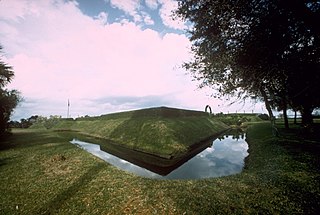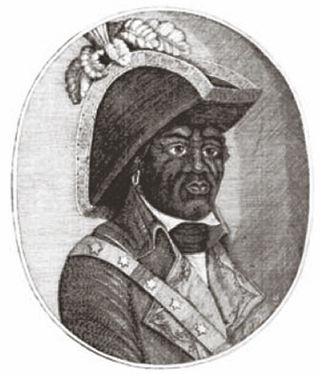Related Research Articles

The Underground Railroad was used by freedom seekers from slavery in the United States and was generally an organized network of secret routes and safe houses. Enslaved Africans and African Americans escaped from slavery as early as the 16th century and many of their escapes were unaided, but the network of safe houses operated by agents generally known as the Underground Railroad began to organize in the 1780s among Abolitionist Societies in the North. It ran north and grew steadily until the Emancipation Proclamation was signed in 1863 by President Abraham Lincoln. The escapees sought primarily to escape into free states, and from there to Canada.

St. Augustine is a city in and the county seat of St. Johns County located 40 miles south of downtown Jacksonville. The city is on the Atlantic coast of northeastern Florida. Founded in 1565 by Spanish colonists, it is the oldest continuously inhabited European-established settlement in what is now the contiguous United States.

The institution of slavery in the European colonies in North America, which eventually became part of the United States of America, developed due to a combination of factors. Primarily, the labor demands for establishing and maintaining European colonies resulted in the Atlantic slave trade. Slavery existed in every European colony in the Americas during the early modern period, and both Africans and indigenous peoples were targets of enslavement by Europeans during the era.
The Stono Rebellion was a slave revolt that began on 9 September 1739, in the colony of South Carolina. It was the largest slave rebellion in the Southern Colonial era, with 25 colonists and 35 to 50 African slaves killed. The uprising's leaders were likely from the Central African Kingdom of Kongo, as they were Catholic and some spoke Portuguese.

Fort Caroline was an attempted French colonial settlement in Florida, located on the banks of the St. Johns River in present-day Duval County. It was established under the leadership of René Goulaine de Laudonnière on 22 June 1564, following King Charles IX's enlisting of Jean Ribault and his Huguenot settlers to stake a claim in French Florida ahead of Spain. The French colony came into conflict with the Spanish, who established St. Augustine in September 1565, and Fort Caroline was sacked by Spanish troops under Pedro Menéndez de Avilés on 20 September. The Spanish continued to occupy the site as San Mateo until 1569.

George Biassou was an early leader of the 1791 slave rising in Saint-Domingue that began the Haitian Revolution. With Jean-François and Jeannot, he was prophesied by the vodou priest Dutty Boukman to lead the revolution.

Slavery in the Spanish American viceroyalties included indigenous peoples, enslaved people from Africa, and enslaved people from Asia. The economic and social institution of slavery existed throughout the Spanish Empire including Spain itself. Enslaved Africans were brought over to the continent for their labour, indigenous people were enslaved until the 1543 laws that prohibited it.

The Black Seminoles, or Afro-Seminoles, are an ethnic group of mixed Native American and African origin associated with the Seminole people in Florida and Oklahoma. They are mostly blood descendants of the Seminole people, free Africans, and escaped former slaves, who allied with Seminole groups in Spanish Florida. Many have Seminole lineage, but due to the stigma of having mixed origin, they have all been categorized as slaves or Freedmen in the past.

Spanish Florida was the first major European land-claim and attempted settlement-area in northern America during the European Age of Discovery. La Florida formed part of the Captaincy General of Cuba in the Viceroyalty of New Spain, and the Spanish Empire during Spanish colonization of the Americas. While its boundaries were never clearly or formally defined, the territory was initially much larger than the present-day state of Florida, extending over much of what is now the southeastern United States, including all of present-day Florida plus portions of Georgia, South Carolina, North Carolina, Alabama, Mississippi, and the Florida Parishes of Louisiana. Spain based its claim to this vast area on several wide-ranging expeditions mounted during the 16th century. A number of missions, settlements, and small forts existed in the 16th and to a lesser extent in the 17th century; they were eventually abandoned due to pressure from the expanding English and French colonial settlements, the collapse of the native populations, and the general difficulty in becoming agriculturally or economically self-sufficient. By the 18th century, Spain's control over La Florida did not extend much beyond a handful of forts near St. Augustine, St. Marks, and Pensacola, all within the boundaries of present-day Florida.

Fort Mose is a former Spanish fort in St. Augustine, Florida. In 1738, the governor of Spanish Florida, Manuel de Montiano, had the fort established as a free black settlement, the first to be legally sanctioned in what would become the territory of the United States. It was designated a US National Historic Landmark on October 12, 1994.

The Battle of Fort Mose was a significant action of the War of Jenkins' Ear that took place on June 14, 1740, in Spanish Florida. Captain Antonio Salgado commanded a Spanish column of 300 regular troops, backed by the free black militia under Francisco Menéndez and allied Seminole warriors consisting of Indian auxiliaries. They stormed Fort Mose, a strategically crucial position newly held by 170 British soldiers under Colonel John Palmer. Palmer and his garrison had taken the fort from the Spanish as part of James Oglethorpe's offensive to capture St. Augustine.

Antonio Benavides Bazán y Molina was a Lieutenant General in the Spanish Army who held administrative positions in the Americas as Royal Governor of Spanish Florida (1718–1734), Governor of Veracruz (1734–1745), Governor and Captain General of Yucatán province, as well as Governor of Manila in the Philippines. Before his successive appointments to these various positions, he served with distinction in several campaigns of the War of the Spanish Succession in 1710, and perhaps saved the life of Philip V, the first Bourbon King of Spain, at Guadalajara.

Negro Fort was a short-lived fortification built by the British in 1814, during the War of 1812, in a remote part of what was at the time Spanish Florida. It was intended to support a never-realized British attack on the U.S. via its southwest border, by means of which they could "free all these Southern Countries [states] from the Yoke of the Americans".
As of the 2010 U.S. Census, African Americans were 16.6% of the population of Florida. The African-American presence in the peninsula extends as far back as the early 18th century, when African-American slaves escaped from slavery in Georgia into the swamps of the peninsula. Black slaves were brought to Florida by Spanish conquistadors.
Fulgencio García de Solís was the acting Governor of Florida from 1752 to 1755, and Governor of Honduras from 1757 to 1759.

Slavery in Florida occurred among indigenous tribes and during Spanish rule. Florida's purchase by the United States from Spain in 1819 was primarily a measure to strengthen the system of slavery on Southern plantations, by denying potential runaways the formerly safe haven of Florida. Florida became a slave state, seceded, and passed laws to exile or enslave free blacks. Even after abolition, forced labor continued.
St. Augustine, Florida, the oldest continuously occupied settlement of European origin in the continental United States, was founded in 1565 by Spanish admiral Pedro Menéndez de Avilés. The Spanish Crown issued an asiento to Menéndez, signed by King Philip II on March 20, 1565, granting him various titles, including that of adelantado of Florida, and expansive privileges to exploit the lands in the vast territory of Spanish Florida, called La Florida by the Spaniards. This contract directed Menéndez to explore the region's Atlantic coast and report on its features, with the object of finding a suitable location to establish a permanent colony from which the Spanish treasure fleet could be defended and Spain's claimed territories in North America protected against incursions by other European powers.
Angola was a prosperous community of up to 750 maroons that existed in Florida from 1812 until Florida became a U.S. territory in 1821, at which point it was destroyed. The location was along the Manatee River in Bradenton, Florida, near Manatee Mineral Springs Park. The exact location is expansive, ranging from where the Braden River meets the Manatee River down to Sarasota Bay; archaeological research focuses on the Manatee Mineral Spring—a source of fresh water and later the location of the Village of Manatee two decades after the destruction of the maroon community. Archaeological evidence has been found and the archaeology report by Uzi Baram is on file with the Florida Division of Historical Resources of the Florida Department of State. In 2019, the National Park Service added the excavated location at Manatee Mineral Springs Park to the Network to Freedom.
Jane Gilmer Landers is an historian of colonial Latin America and the Atlantic World who specializes in the history of Africans and their descendants. She is the Gertrude Conaway Vanderbilt Professor of History at Vanderbilt University, director of the Center for Latin American and Iberian Studies, and former associate dean of the college of arts & science.
African Americans have made considerable contributions to the history and development of Jacksonville, Florida. According to the U.S. Census Bureau, the population make up of African American in Jacksonville Florida is 30.7%.
References
- ↑ Landers, Jane (1999). Black Society in Spanish Florida. Urbana, Illinois: University of Illinois Press.
- ↑ "Aboard the Underground Railroad – Fort Mose Site". National Park Service . Retrieved February 15, 2023.
- ↑ Landers, Jane (2005). "Leadership and Authority in Maroon Settlements in Spanish America and Brazil". In Curto, José C.; Soulodre-LaFrance, Renée (eds.). Africa and the Americas: Interconnections During the Slave Trade. Africa World Press. p. 177. ISBN 978-1-59221-272-9.
- ↑ Miller, Christine; Williams, Kailey (Spring–Summer 2020). "Fort Mose: America's First Free Black Settlement". Journal of America's Military Past . 45 (2): 5–10.
- ↑ https://www.acls.org/wp-content/uploads/2023/02/Biography_and_the_Black_Atlantic_-_Chapter_10._The_Atlantic_Transformations_of_Francisco_Menendez-1-1.pdf [ bare URL PDF ]
- ↑ Landers, Jane (3 October 2013). "The Atlantic Transformations of Francisco Menéndez". In Lindsay, Lisa A.; Sweet, John Wood (eds.). Biography and the Black Atlantic. University of Pennsylvania Press. p. 213. ISBN 978-0-8122-4546-2.
- ↑ "Fort Mose Site: Florida". www.nps.gov. National Park Service. Archived from the original on January 16, 2018. Retrieved 13 May 2018.
- ↑ Jane Landers (February 2010). Atlantic Creoles in the Age of Revolutions. Harvard University Press. p. 3. ISBN 978-0-674-03591-1.
- ↑ Ira Berlin (11 January 2013). "The Origins of African-American Society". In Laurent Dubois; Julius S. Scott (eds.). Origins of the Black Atlantic. Routledge. p. 124. ISBN 978-1-136-09634-1.
- ↑ Landers, Jane (January 1984). "Spanish Sanctuary: Fugitives in Florida, 1687–1790". The Florida Historical Quarterly. 62 (3): 297–298, 300. JSTOR 30146288.
- ↑ Riordan, Patrick: "Finding Freedom in Florida: Native Peoples, African Americans, and Colonists, 1670-1816", Florida Historical Quarterly 75(1), 1996, pp. 25-44.
- ↑ Berlin, Ira. Many Thousands Gone, Belknap Press, 1998, p. 74
- ↑ Jane Landers (February 1990). "Gracia Real de Santa Teresa de Mose - A Free Black Town in Spanish Colonial Florida" (PDF). The American Historical Review. 95 (1). Oxford University Press: 17. doi:10.1086/ahr/95.1.9.
- ↑ Landers, Jane (1999). Black Society in Spanish Florida. University of Illinois Press. p. 29. ISBN 0-252-06753-3.
- 1 2 Lisa A. Lindsay; John Wood Sweet (2014). Biography and the Black Atlantic. University of Pennsylvania Press. p. 222. ISBN 978-0-8122-4546-2.
- ↑ Magazine, Hakai. "When Places Dense with Relics and Remembrances Succumb to the Sea". Hakai Magazine. Retrieved 2022-08-06.
- ↑ Turner., Glennette Tilley (2010). Fort Mose: and the story of the man who built the first free black settlement in colonial America . Abrams Books for Young Readers. ISBN 9780810940567.